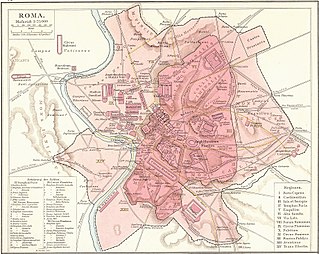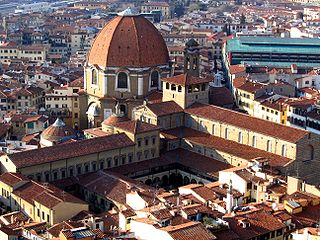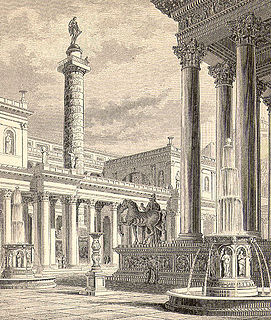
Trajan was Roman emperor from 98 to 117. Officially declared by the Senate optimus princeps, Trajan is remembered as a successful soldier-emperor who presided over the second-greatest military expansion in Roman history, after Augustus, leading the empire to attain its maximum territorial extent by the time of his death. He is also known for his philanthropic rule, overseeing extensive public building programs and implementing social welfare policies, which earned him his enduring reputation as the second of the Five Good Emperors who presided over an era of peace within the Empire and prosperity in the Mediterranean world.

Decebalus was the last king of Dacia. He is famous for fighting three wars, with varying success, against the Roman Empire under two emperors. After raiding south across the Danube, he defeated a Roman invasion in the reign of Domitian, securing a period of independence during which Decebalus consolidated his rule.

Trajan's Column is a Roman triumphal column in Rome, Italy, that commemorates Roman emperor Trajan's victory in the Dacian Wars. It was probably constructed under the supervision of the architect Apollodorus of Damascus at the order of the Roman Senate. It is located in Trajan's Forum, north of the Roman Forum. Completed in AD 113, the freestanding column is most famous for its spiral bas relief, which artistically represents the wars between the Romans and Dacians. Its design has inspired numerous victory columns, both ancient and modern.

A pedestal or plinth is the support of a statue or a vase, and of a column in architecture. Smaller pedestals, especially if round in shape, may be called socles. In civil engineering, it is also called basement. The minimum height of the plinth is usually kept as 45 cm. It transmits loads from superstructure to the substructure and acts as the retaining wall for the filling inside the plinth or raised floor.

Italica north of modern-day Santiponce, 9 km northwest of Seville in southern Spain, was an Italic settlement founded by the Roman general Scipio in the province of Hispania Baetica. It was the birthplace of Roman Emperors Trajan, Hadrian, and Theodosius (possibly). It flourished under the reign of Hadrian, becoming an elaborate urban centre and obtaining the high status of colonia. The modern town of Santiponce overlies the pre-Roman Iberian settlement and part of the well-preserved Roman city.

The Laurentian Library is a historic library in Florence, Italy, containing more than 11,000 manuscripts and 4,500 early printed books. Built in a cloister of the Medicean Basilica di San Lorenzo di Firenze under the patronage of the Medici pope Clement VII, the library was built to emphasize that the Medici were no longer merchants but members of intelligent and ecclesiastical society. It contains the manuscripts and books belonging to the private library of the Medici family. The library is renowned for its architecture, designed by Michelangelo, and is an example of Mannerism.

Trajan's Forum was the last of the Imperial fora to be constructed in ancient Rome. The architect Apollodorus of Damascus oversaw its construction.

Theveste was a Roman colony situated in the present Tébessa, Algeria.

Trajan's Market is a large complex of ruins in the city of Rome, Italy, located on the Via dei Fori Imperiali, at the opposite end to the Colosseum. The surviving buildings and structures, built as an integral part of Trajan's Forum and nestled against the excavated flank of the Quirinal Hill, present a living model of life in the Roman capital and a glimpse at the restoration in the city, which reveals new treasures and insights about Ancient Roman architecture.
The Plutei of Trajan are carved stone balustrades built for the Roman emperor Trajan. They are on display inside the Curia Julia in the Forum Romanum today, but are not part of the original structure.

Pluteus is a large genus of fungi with over 300 species. They are wood rotting saprobes with pink spore prints and gills that are free from the stem.

The Pallavicini family, also known as Pallavicino and in former times named Pelavicino, is an Italian noble family founded by Adalbert II Pelavicino of the Frankish Obertenghi family.

Pluteo 29.1, also known as Pluteus 29.1, or simply the Florence Manuscript, is an illuminated manuscript in the Laurentian Library of Florence.
Pluteus glaucus is a mushroom in the family Pluteaceae.
Pluteus nigroviridis is a mushroom in the family Pluteaceae. Found in Europe, it was first described scientifically by Hungarian mycologist Margit Babos in 1983.

Proletarian Democracy was a Left-wing political party in Italy.

Pluteus americanus is a North American and Russian psychedelic mushroom that grows on hardwoods.

The Bibliotheca Ulpia was a Roman library founded by the Emperor Trajan in AD 114 in his forum, the Forum of Trajan, located in ancient Rome. It was considered one of the most prominent and famous libraries of antiquity and became the major library in the Western World upon the destruction of the Library of Alexandria in the 3rd century. It was the only Roman library to survive until the Fall of Rome in the mid-fifth century.
Trajanic art is the artistic production of the Roman Empire during the reign of Emperor Trajan from 98 to 117. In this period, Roman art further developed the innovations of the Flavian era, coming to definitively detach itself from Hellenistic influence.
Pluteus is a large genus of fungi. It may also refer to:
















